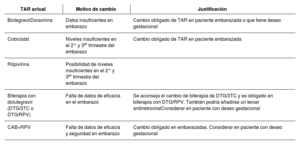Desde el descubrimiento del virus de la inmunodeficiencia humana (VIH) en 1983, tanto la epidemiología como el pronóstico de la infección por el VIH han cambiado notablemente, gracias al desarrollo del tratamiento antirretroviral (TAR). Actualmente, el desarrollo de un TAR eficaz ha cambiado la historia natural de la infección, permitiendo que las personas que viven con infección por el VIH (PVVIH) tengan una esperanza de vida similar a la de la población general. La administración del TAR es universal para todos los PVVIH, siendo muy similar la pauta de inicio entre las principales guías clínicas. Habría que tener en cuenta ciertas situaciones especiales en las que se debería modificar el TAR. El objetivo es conseguir la supresión virológica y revertir el estado de inmunosupresión con la menor toxicidad posible y monitorizando las posibles interacciones de los distintos antirretrovirales. Se están desarrollando nuevos fármacos que permiten una administración a largo plazo, y además se convertirían en una alternativa en los fracasos virológicos. Por otro lado, el uso de antirretrovirales en la prevención del VIH ante la exposición en situaciones de riesgo ha permitido la disminución de la transmisión de esta infección.
Palabras clave
Since the discovery of human immunodeficiency virus (HIV) in 1983, both the epidemiology and the prognosis of HIV infection have changed notably thanks to the development of antiretroviral therapy (ART). Currently, the development of effective ART has changed the natural history the infection, allowing for people living with HIV (PLHIV) to have a life expectancy similar to that of the general population. The administration of ART is universal for all PLHIV, with very similar starting regimen among the main clinical guidelines. Certain special situations in which ART must be modified must be taken into account. The aim is to achieve viral suppression and revert the immunosuppressed state with the least toxicity possible while monitoring probable interactions among the various antiretroviral agents. New drugs are being developed that allow for long-term administration and which will also become an alternative in cases of virologic failure. What's more, the use of antiretrovirals in HIV prevention prior to exposure in situations of risk has allowed for decreasing the transmission of this infection.
Keywords
Identifíquese
¿Aún no es suscriptor de la revista?
Comprar el acceso al artículo
Comprando el artículo el pdf del mismo podrá ser descargado
Teléfono para incidencias
De lunes a viernes de 9h a 18h (GMT+1) excepto los meses de julio y agosto que será de 9 a 15h







